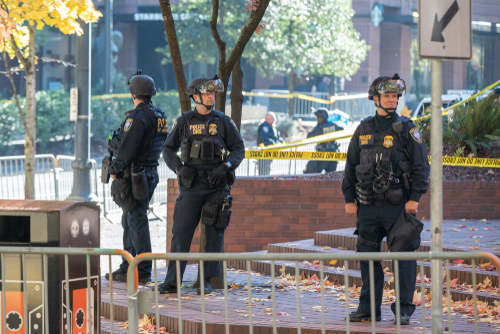
The U.S. government has changed course in terrorism prevention efforts since Sept. 11, 2001, relying more on community networks at the local level rather than a top-down approach from federal agencies, including the Department of Homeland Security.
That was part of the message delivered by Elizabeth Neumann, Assistant Secretary for Threat Prevention and Security Policy, DHS, last week at an event sponsored by the Heritage Foundation. The discussion, Building an Effective Approach to Terrorism Prevention, focused on a more than 300-page report recently issued by the RAND Corporation in cooperation with DHS.
Between 2002 and 2016, 943 individuals were radicalized in the United States, with 382 (roughly 40 percent) of these cases occurring in 2012 or later. The individuals radicalized through a mix of ideologies: 47 percent were Islamist, 37 percent were far-right, 9 percent were single-issue, and 8 percent were far-left, according to the RAND report, Practical Terrorism Prevention: Reexamining U.S. National Approaches to Addressing the Threat of Ideologically Motivated Violence.
“Around 2008 we started to see the threat was changing. We started to see a surge of people leaving the United States to fight with terrorist groups abroad. We had young men from Minneapolis traveling to Africa to join Al-Shabaab, leaving friends and family mystified and devastated. So, we realized there was another gap that needed to be filled,” Neumann said.
The gap was between law enforcement and community members. As one way to address this, some communities focus on role reversal techniques to foster greater empathy and trust between its members and the police.
The authors of the RAND report interviewed stakeholders across the United States and in other countries with terrorism prevention programs. They found that the biggest success stories included community education programs, some of which DHS had been engaged in for more than a decade through roundtables organized by its Office for Civil Liberties and Civil Rights.
Some other initiatives are not without debate, as the report states:
“Current terrorism prevention and past CVE (Countering Violent Extremism) efforts in the United States have been controversial. Since these efforts often respond to activities that are not crimes, there are serious concerns regarding the potential to infringe on constitutionally protected rights, stigmatize individuals and communities, or damage trust between the government and the public. It is difficult to know who to focus on for terrorism prevention efforts, given that there are no unambiguous early indicators of future violent behavior and limited means available to distinguish those individuals who appear to be threats from those who actually do pose a threat.”
The RAND report also noted that challenging terrorist narratives is one of the most difficult tasks for the federal government but one that can’t be ignored, especially given the prevalence of online propaganda from both international and domestic terrorists. More than any other area, this is where private-public partnerships are critical, Neumann said.
She cited Facebook as a partner in finding and eliminating terrorist propaganda before it becomes widely available online. And the RAND report remarked on the achievements of the Digital Forum on Terrorism Prevention—a conglomeration of tech companies, NGOS, and other groups in which DHS is the convener to address terrorist ideology.
Seamus Hughes, deputy director of the Program on Extremism at George Washington University, also participated in the discussion.
“Has the ship sailed on countering violent extremism because the waters have been so muddied for the last five to ten years? The short answer is no,” Hughes said. “However, I don’t see the government set up to do counter propaganda domestically…I don’t see the tech companies having incentives barring political pressure.”
In 2016 when the National Preparedness Goal report was issued highlighting its five mission areas (prevention, protection, mitigation, response and recovery), federal officials realized the government hadn’t spent as many resources on the prevention aspect as they had on the other areas.
“Notably, we don’t have a central operational component headquarters office that addresses prevention in the same way that NPPD (National Protection and Programs Directorate) or FEMA do for their respective missions,” Neumann said.
Having a central operational component may be key to combating the threats of domestic terrorism, which is increasing.
As domestic terrorism gains traction, more individuals are also motivated by violence as an ideology itself, joining groups that they can infiltrate to manifest their individual extremism.
Border patrol agents are seeing the same ‘violence as an ideology’ in transnational criminal organizations, as members of drug cartels have become increasingly more violent than that of the older generation, Neumann said.




